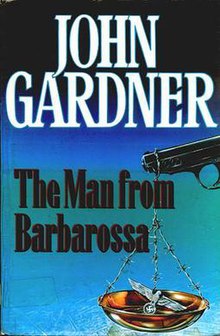Bond. James Bond. In the 007 Case Files, join me as I read all of the James Bond books, encompassing Ian Fleming and beyond. For Your Eyes Only: there’s spoilers ahead.
John Gardner’s 11th James Bond outing is something of an anomaly. It is one of the more distinctively ‘Gardner books’ in the mix, thoroughly acknowledging the world as it stood in the early 1990s. Yet critics and fans remain mixed on its merits, and perhaps now with time we can reassess it a little.
Gardner was immensely proud of the book, originally released in the UK in August 1991. “I think the best of my Bonds is THE MAN FROM BARBAROSSA: it was also [publisher] Glidrose’s favourite,” he said on a now-archived version of his website. “But when we handed it to the American publishers they screamed in agony – ‘This isn’t the mixture as before,’ they shrieked. Which was exactly what I was aiming for.”
This different approach comes flying at the reader from the opening pages. Following an epigraph for Babi Yar, a ravine in the Ukrainian capital Kyiv known for atrocities carried out by Nazis in the Second World War, Gardner delivers a harrowing account of the Jews massacred during Operation Barbarossa, the German invasion of the USSR. In the present day, an elderly American is kidnapped by a Russian terrorist group called The Scales of Justice, done so on the mistaken belief that he is a war criminal responsible for the historic massacre.
Gardner then brings both James Bond and the reader right up to the present day, as Bond is partnered with an Israeli Mossad agent and work with the KGB to infiltrate the Scales of Justice. They discover there is much more at stake than an elderly man kidnapped from New Jersey, including a plot to sabotage perestroika (Mikhail Gorbachev’s openness policy and reformation of the Party), while supplying Iraq with nuclear weapons.
Gardner distinguishes THE MAN FROM BARBAROSSA from his previous ten outings in a number of unique ways. Along with updating some of the chronological references, making it unlikely Bond was operating as a 00 agent in 1960s, it is consciously set outside the typical world of Bond. Here, 007 takes his orders not from M but the KGB. This is a world on the brink of war, filled with more political manoeuvring than straight-up action. (See also: Icebreaker). There’s a stretch when Gardner fakes out the reader with Bond’s supposed death, meaning we have a book where Bond is partially absent.
The last time that a Bond book attempted to take a completely experimental approach with the Bond formula was Fleming’s own The Spy Who Loved Me, a book told entirely from the perspective of a woman who only had a brief connection to Bond. Some fans have compared the two books, and there is much to be said for this. Like The Spy Who Loved Me, this volume is also the most sexually explicit of the Bond stories to this point, with several distinct sex scenes that would make the fans of the film series blush.
Perhaps responding to Licence to Kill, or perhaps the inevitable end of the Cold War, Gardner seems to settle into his own groove — which is probably why he was always so proud of this outing. While I personally found the mix of tones somewhat jarring at times, it was the first Bond book in a few entries that I was a little more engaged with for the duration.
James Bond will return…in Death is Forever.





